The needs of an occlusal scheme for complete dentures are dramatically different from those of natural dentition. Denture occlusion must be designed to minimize the tipping and movement of the dentures in order to minimize trauma to the underlying tissue during parafunction. This program highlights the difference between the two situations and makes a strong argument for the employment of bilateral balance occlusal schemes for complete dentures.
Complete Dentures – Natural vs. Complete Denture Occlusion — Course Transcript
- 1. 13. Natural vs. Complete Denture Occlusion Michael Hamada DDS Division of Advanced Prosthodontics, Biomaterials and Hospital Dentistry UCLA School of Dentistry This program of instruction is protected by copyright ©. No portion of this program of instruction may be reproduced, recorded or transferred by any means electronic, digital, photographic, mechanical etc., or by any information storage or retrieval system, without prior permission.
- 2. Natural Dentition:Organic Occlusion Organic occlusions present in a variety of individual tooth size, shape, form and alignment, but ideally exhibit certain characteristic features.
- 3. Natural Dentition:Organic Occlusion Bilateral Posterior Centric Contact Anterior Guidance Mutually Protective Scheme of Occlusion
- 4. Complete Denture Occlusion Likewise, complete denture occlusions present in a variety of forms, but also exhibit certain common characteristics
- 5. Complete Denture Occlusion Bilateral Posterior Centric Contact Centralized Forces “ Balance” to minimize tipping
- 6. Differences between Natural and Complete Denture Occlusion
- 7. Differences between Natural and Complete Denture Occlusion Arise from fundamental differences in Sensory Feedback Mechanism Derivation of : Retention Stability Support Reaction of Supporting Structures to Masticatory Forces
- 8. Differences between Natural and Complete Denture Occlusion Neuromuscular and Sensory Feedback Precision of feedback may be somewhat compromised following loss of teeth and associated structures
- 9. Differences between Natural and Complete Denture Occlusion Derivation of Retention, Stability and Support Fundamental differences between how they derive retention, stability and support dictate differences in occlusion design between natural and CD occlusion
- 10. Retention, Stability and Support Retention Denture Bearing Surface Resistance to dislodgment forces in a vertical direction away from the bearing surface
- 11. Retention, Stability and Support Stability Denture Bearing Surface Resistance to laterally oriented dislodgment forces
- 12. Retention, Stability and Support Support Denture Bearing Surface Factors of the Bearing Surface which resist forces in a vertical direction towards the bearing surface
- 13. Differences between Natural and Complete Denture Occlusion For natural dentition, derived through the periodontium, providing: Sensory Feedback Mechanism Difference in reaction of Supporting Structures to Masticatory Forces Differences in load transfer mechanism and physiology Derivation of Retention, Stability and Support
- 14. Differences between Natural and Complete Denture Occlusion Residual Ridge Resorption (RRR) Non-physiologic compression (as may occur under denture bases) results in further resorption, as compared to . . . Physiologic levels of tension results in apposition (such as that transmitted by loading the PDL through natural dentition)
- 15. Mobile bases on mucosa Teeth move as an unit Malocclusion affects entire base immediately Non-vertical forces affect all teeth and is traumatic Incising affects all teeth attached to base Bilateral balance is often desired for base stability Decreased tactile sense Differences between Natural and Complete Denture Occlusion Retained in PDL Units move independently Malocclusion effects not immediate Non-vertical forces affect only teeth involved and usually well tolerated Incising doesn’t affect posteriors Bilateral balance is rare Tactile sensitivity Natural Dentition Denture “Dentition”
- 16. Complete Denture Occlusion Because of compromises inherent in restoring the edentulous arch, CD tooth forms and arrangements (i.e. occlusion), should be designed to provide function and aesthetics while MINIMIZING DENTURE BASE TIPPING (LATERAL) FORCES Denture “Dentition”
- 17. Summary Goal of complete denture occlusion is preservation of structure and restoration of function and esthetics Consequences of tooth loss create anatomic changes which result in differences in derivation of retention, stability and support between natural and complete denture teeth
- 18. Summary The differences in the design of natural and complete denture occlusion are the consequence of differences in the derivation of retention, stability and support Complete denture form and tooth placement is biomechanical in nature


